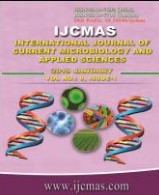


 National Academy of Agricultural Sciences (NAAS)
National Academy of Agricultural Sciences (NAAS)

|
PRINT ISSN : 2319-7692
Online ISSN : 2319-7706 Issues : 12 per year Publisher : Excellent Publishers Email : editorijcmas@gmail.com / submit@ijcmas.com Editor-in-chief: Dr.M.Prakash Index Copernicus ICV 2018: 95.39 NAAS RATING 2020: 5.38 |
Distillery is one of the most highly polluting and growth oriented industries in India with reference to the extent of water pollution and the quantity of wastewater generated. Apart from distilleries, fermentation industries, sugar mills, pharmaceutical companies and other molasses based industries are also responsible for contamination and generation of waste water. The distillery waste water contains dark brown colored recalcitrant compounds collectively termed as melanoidin polymers. These polymers cause oxygen depletion and increase BOD. In soil they reduce the soil alkalinity and manganese availability, inhibit seed germination and affect vegetation. The distillery wastewater poses a serious threat to water quality in several regions of the country. Its disposal on land is equally detrimental causing a reduction in soil alkalinity and inhibition of seed germination. The conventional methods of water treatment fail to remove melanoidin. There is thus an urgent need to control and remediate the melanoidin contamination and in current perspective microorganisms have proved to be an efficient scavenger. They have shown tremendous ability to utilize melanoidin as their source of nutrition and remediate the polluted water. The microbial approach for treatment of melanoidin contamination seems to be the solution over the conventional methods that fail to remove the contamination of pigment.
 |
 |
 |
 |
 |